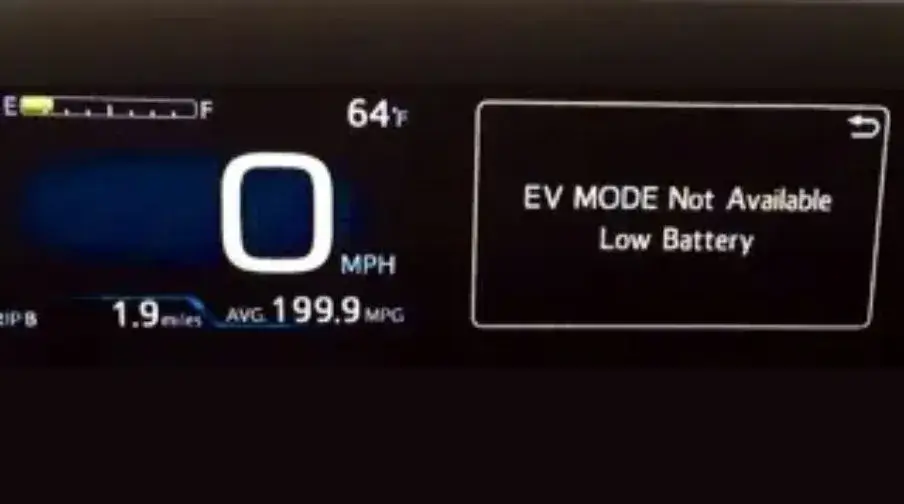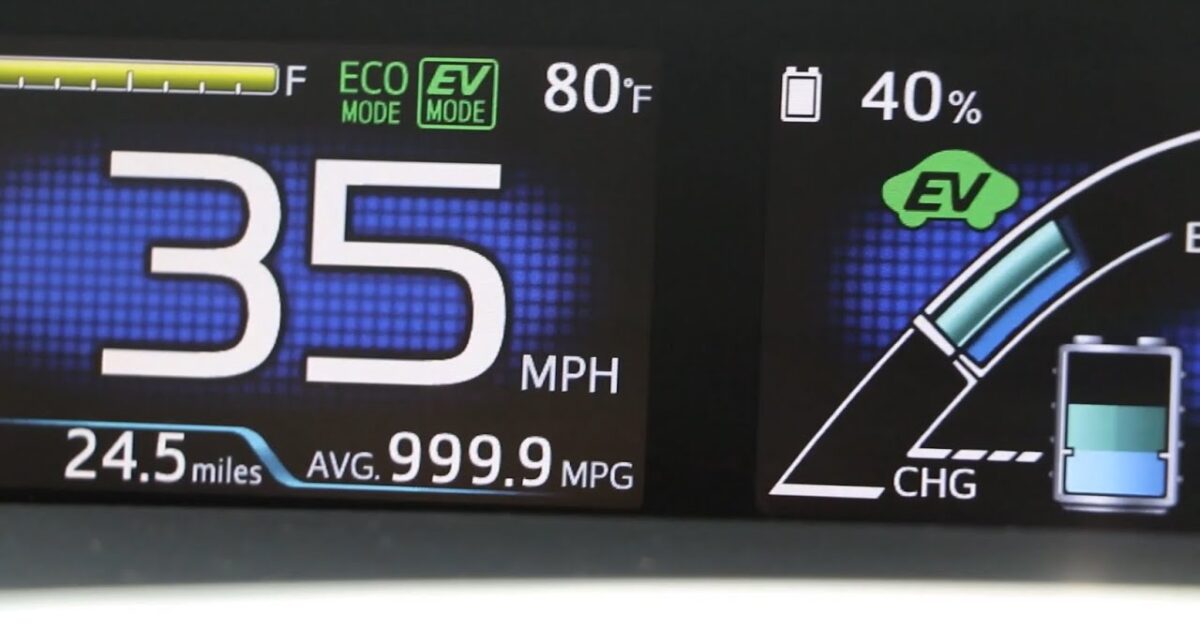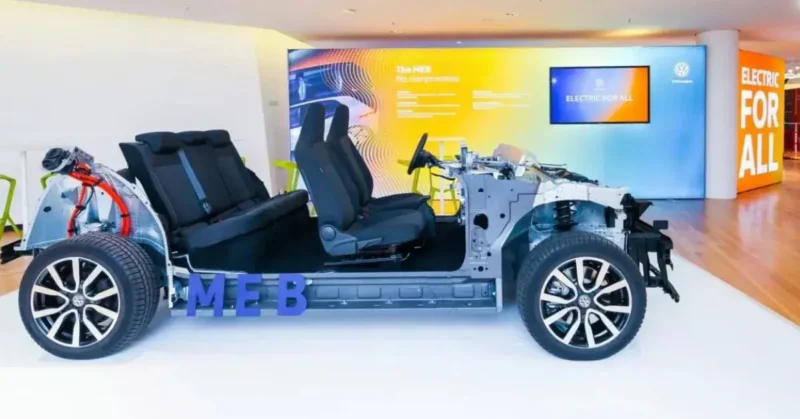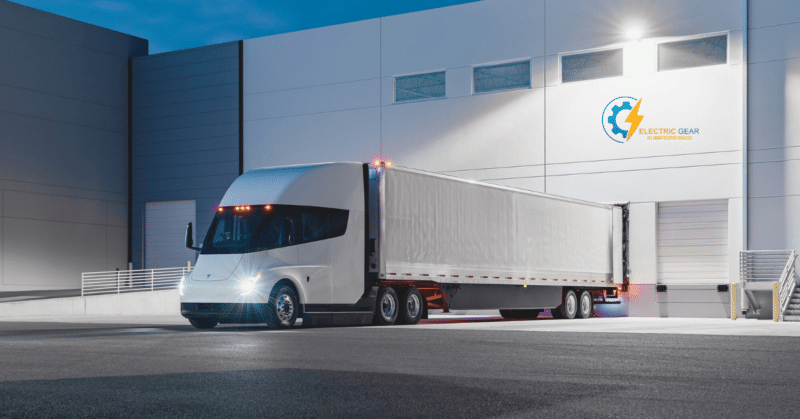EV mode means “Electric Vehicle Mode.” This feature is only available on hybrid cars and doesn’t work until some other features work. In EV mode, the car’s battery is its only energy source. It lets you drive efficiently but takes away some of the vehicle’s power.
What is EV Mode
In EV Mode, you’ll only be using electric power, which means less pollution and more efficiency. While in EV mode, the vehicle produces almost no noise.
Since EV Mode reduces road noise, it is better for commuting through quiet neighborhoods early in the morning. Unless specific criteria are satisfied, EV mode will not engage.
Within an approximate 25-mile range, EV Mode lets you drive entirely on electric power. When the driver chooses EV Mode, the car does several tests, such as checking the hybrid system and coolant temperature, the battery charge level, the speed at which it accelerates, and where the pedals are.
If any of these conditions are not met, EV Mode will be disabled, and a notice reading “EV Mode is currently unavailable” will be shown on the display screen.
EV Mode Meaning
Given these limitations, EV mode is best used for relatively short trips that only call for a bit of speed, like getting the car out of the garage or driving across the town. Since vehicles in EV mode may be almost quiet, drivers should be cautious.
EV Drive Mode is standard on several Toyota hybrid models, enabling them to function as pure electric vehicles when necessary.
The hybrid battery provides electric Power in EV Drive Mode, and the electric motor offers quiet, emission-free propulsion. This mode can be a useful option in late-night residential neighborhoods, indoor parking garages, or other situations where noise and exhaust emissions are an issue.
While operating in EV mode, drivers should exercise extra caution since their cars may become almost quiet.
Because of this, pedestrians, cyclists, and drivers of other vehicles may be unable to hear an EV approaching them. In light of this, when using this function, you must always pay great attention to your surroundings.
EV Mode vs. ECO Mode
EV Mode
The Electric Vehicle mode is exclusive to hybrid cars and has a particular use. While an automobile is in EV mode, it uses its battery energy.
Although this might lead to incredibly efficient driving, it is also possible that the car using EV mode will not have as much power as it would have while the engine is running.
Because of this, EV mode may only be used for a maximum of one mile and under certain situations at extremely low driving speeds. Because of these limitations, EV mode should be used only for the briefest of trips, such as backing out of a parking spot or pulling a car out of your garage.
Eco Mode
Due to the constraints listed above, driving in EV mode is recommended only for short distances where there is no or less need for high speeds, such as moving the vehicle.
These days, most automobiles have an “eco” option that helps save gas. The engine’s power is lowered while it’s on, reducing its effort and making the gas pedal less responsive. A decrease in power causes the vehicle’s acceleration to slow down.
If you want better gas mileage from your car, you should always drive in Eco Mode. It may include long periods spent in the city, on the motorway, or even touring the country roads. Eco Mode is the best option when you’re not in a rush and have time to spare.
Other Modes Power, Sport, and Snow
Other modes, for instance, Power and Sport modes, are equivalent because they both boost the vehicle’s maximum speed. This adjustment makes the engine seem more powerful since drivers may press the accelerator with less resistance.
None of the driving modes we’ve talked about so far changes (either increases or decreases) the engine’s physical power. Instead, the mode changes how hard the driver has to work to get where they want to go.
It’s excellent for quick access to the car’s acceleration and braking. If, for instance, you need to accelerate quickly to merge onto the highway, the function will help you considerably.
Snow mode improves your car’s traction control while driving on slick or slippery surfaces. It might help your car go faster and drive more safely in snow and other similar conditions.
When to use EV Mode
Switch to electric-only propulsion by pressing the EV button to reduce noise pollution. If you intend to drive your car at roughly 25 mph, EV Mode lets you go entirely on electric power for a short distance.

With EV Drive Mode engaged, the gas engine may resume automatically if:
When the following conditions are met:
- the hybrid battery is low;
- the vehicle is traveling at a fast rate of speed;
- the accelerator pedal is being depressed heavily; and
- the vehicle is traveling uphill.
Conditions in which EV drive mode cannot be turned on
There are several conditions under which activating EV driving mode may be impossible. A buzzer will ring, and a notice will appear on the screen if it cannot be turned on.
- The hybrid system’s temperature is relatively high. The vehicle’s been subjected to various cases of abuse, such as being left in the sun and driven downhill at high speeds.
- The hybrid system is cool to the touch.
- The automobile has been stored for an extended period at temperatures below 32 degrees Fahrenheit (0 degrees Celsius).
- The gas-powered engine is almost ready to go.
- The hybrid system’s traction battery is almost dead.
- The energy monitor’s indication of remaining battery life is dismal.
- High rates of speed are being achieved by the vehicles.
- If the automobile goes downhill, the gas pedal is pushed hard.
- A defogger for the windscreen is on.
Benefits of EV Mode
There are several benefits to this mode:
- Using electric power, EV mode produces fewer harmful emissions and performs better.
- EV Mode is almost silent; you may use it to generate less noise if you travel early in the morning in calm areas.
- The following scenarios will allow EV mode to function: Inadequate battery charge keeps your vehicle in normal mode. You need not be concerned with any reduction in range.
- The electric vehicle mode’s zero-emissions and increased efficiency result from its exclusive electrical power usage.
- The EV mode is really quiet. Since EV Mode reduces road noise, it is better for commuting through quiet neighborhoods early in the morning.
When those requirements are satisfied, only then will EV mode engage. A lack of battery power will keep your car in its default “Normal” setting. You won’t have to worry about losing the signal.
Conclusion
EV Mode and ECO Mode are useful features in modern cars that are meant to make them more fuel-efficient and less harmful to the environment. EV Mode lets hybrid and plug-in hybrid cars run on electricity alone for short lengths, which cuts down on pollution and gas use.
ECO Mode makes the car run better so it uses less gas and puts out less pollution. This makes it perfect for long trips and going on the highway. Knowing about these modes helps drivers make smart choices that will make their driving experience better and help the environment.

Imran is an experienced content writer who crafts engaging and informative articles for a variety of industries. With a keen eye for detail and a passion for storytelling, Imran delivers high-quality content that resonates with readers. Whether he’s writing blog posts, social media content, or website copy, Imran is committed to delivering compelling content that drives results.







